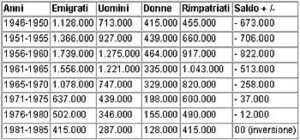January 10, 2025 Hidden history
Indeed, the Italian citizen, like any other alien, had no vested rights.
Italian immigration in the world

At present, with the usual timeliness of the collective memory in the removal of a burden that has become very cumbersome, there is a tendency to consider the immigration of our compatriots as a very distant event in history.
The perception that we have always been a “receiving” country, with all the economic, legal and social consequences that this entails, has now prevailed.
In this comparison, the great absentee at the moment seems to be memory.
In fact, the negative balance between emigration and repatriation was not overcome until the 1980s, and although the trend reversal was already evident in the 1970s, the phenomenon of emigration abroad still involved hundreds of thousands of people.
First of all, it is necessary to clarify the significance of the flow of Italians: it was, without fear of contradiction, the most massive migratory flow in modern and contemporary history.
Since the first half of the nineteenth century, almost twenty-five million Italians have sought their “fortune” in every corner of the world.
If we consider the Italian population immediately after the breach of Porta Pia (1870), it is easy to estimate the magnitude of the phenomenon.
Moreover, another element of fundamental importance is the “northern” prevalence of the population outflow since the early twentieth century, as demonstrated by the quantity and quality of information available online for the regions of Piedmont and Friuli Venezia Giulia, and more generally for all the regions of northern Italy.
Further confirmation comes from estimates of the number of Italians in the world, which is currently estimated at around 60 million, although only four million are counted by AIRE (the register of Italians living abroad, managed by the Ministry of the Interior).
If, instinctively, we still think of the ships of hope from “The Legend of 1900“, which transported to Ellis Island, the border of entry into the United States, a multitude of desperate or almost desperate people (the author of these lines, for example, retains an eerie memory of the Museum of Immigration located there, across the harbor from New York City), in reality, history brings the very last fires of this phenomenon back to 1970, precisely during the World Cup in Mexico.
The Palermo newspaper L’Ora published puzzling statements about the existence of “an underworld organization that dealt with the illegal emigration to the United States, across the Mexican border, of Italian citizens who had moved to that country under the guise of being fans of the Italian national soccer team“.
There was a great deal of publicity about this affair, even if, in my opinion, it did not fit in with an emigration that had already experienced episodes of extreme drama in previous years (just think of the deaths of Italian illegal immigrants on the northwestern crossings while trying to reach France) and that still maintained a massive consistency in those areas of Europe where this role in industry and society was customarily played, a role that today is attributed in exactly the same way to Eurasian populations, Mediterranean and African ethnic groups.
In the two-year period 1971-1973, when the period of maximum Italian immigration to America and Australia had definitely passed, the number of Italian citizens in Germany was constantly around 50,000.
While in the early 1960s, with 121,000 workers, Italians made up almost half of the immigrants in Germany, by 1973 the number had risen to 423,000, the highest ever.
It should also be noted that in 1973 almost three-quarters of the workers were unskilled.

In other words, they were not students, skilled technicians, or managers, categories that nevertheless had a significant presence in Germany.
The number of Italians in Germany rose from 400,000 at the end of the 1960s to 650,000 in 1972 and then settled at around 600,000 in 1975.
The situation was not much different in Switzerland, where the presence of immigrants was subject to the provisions of the Federal Law on the Residence and Settlement of Foreigners of 1931 and 1948, in force until 1978.
This law reiterated the “principle of the free decision of the authorities“, which in fact subordinated the material guarantees of residence on Swiss territory to the subjectivity of the unquestionable judgment of the local authorities.
In fact, the Italian citizen, like any other foreigner, had no acquired rights, and the Italian population, in particular, was subjected to episodes of racial discrimination that were the source of not insignificant diplomatic tensions between the two countries.
At the beginning of the 1960s, our compatriots constituted the majority of foreign workers in Switzerland, accounting for two-thirds of the total, and in 1970 they still accounted for more than 60 percent, only to fall to about 40 percent in 1975, coinciding with the economic crisis of the period under consideration, the year in which the Yugoslavs and Turks began to play the unenviable role of last in class, but also in which the largest foreign resident population was reached, with 587,000 people.
The construction, clothing, and textile sectors have the largest presence, with 86.3 percent, 79.4 percent, and 76 percent, respectively, in 1968, mostly in low-level jobs.
On the other hand, the presence in the more qualified sectors (technical, commercial, services, health) is low, confirming the low cultural and professional profile of our emigrants at that time.














